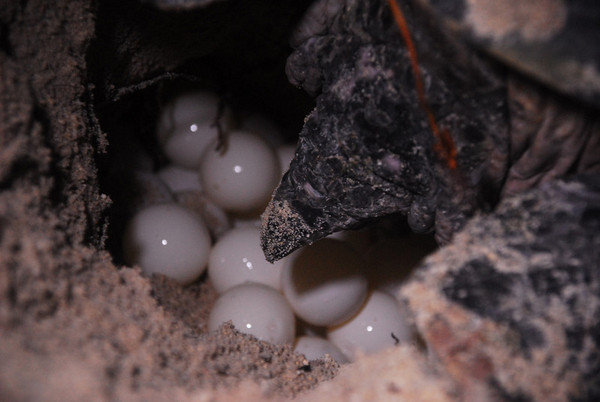Sea Turtle Baby Boom Smashes Record


Green turtles laid more than 1 million eggs last year on one of the Turtle Islands in the southern Philippines. That number of slimy turtle eggs set an all-time high since recording of nesting started in 1984.
Some 14,220 green turtle nests were found on Baguan Island in 2011, breaking the previous record of 12,311 nests set in 1995. The 2011 figures translate to 2,844 nesting green turtles and 1.44 million turtle eggs laid, according to the Philippines' Department of Environment and Natural Resources and the conservation group Conservation International.
"1.44 million eggs is an astounding number and it presents great hope for boosting green turtle populations," said Romeo Trono, executive director of Conservation International in the Philippines.
With an average of 90 percent hatching success and a 1 percent survival rate up to sexual maturity, the turtle baby boom in Baguan in 2011 alone could contribute 13,000 individuals to the adult turtle population, Trono said.
Ups and downs
Baguan is one of the nine islands of the Turtle Islands Heritage Protected Area, a protected area jointly managed by Malaysia and the Philippines. Baguan is one of six islands of the Philippines' Turtle Islands Wildlife Sanctuary. [Colorful Creatures of the Philippines]
Since the previous high in 1995, Baguan's nesting records have been declining and dropped to as low as just over 4,000 nests in 2003, according to figures from the Department of Environment and Natural Resources.
Get the world’s most fascinating discoveries delivered straight to your inbox.
Poaching by foreign fishermen, egg harvesting for food and trade, illegal fishing methods and weak law enforcement contributed to the decline in the sea turtle population in the sanctuary.
"The increasing nest numbers show that when turtles are protected on their nesting beaches and in the water for long enough, they will recover," said Bryan Wallace of Conservation International.
Law enforcement in Baguan has been strengthened though agency partnerships that provided trainings to park wardens, law enforcers and community volunteers and boosted patrolling. The Philippine Turtle Islands' enforcement team also includes officers from the Philippine Coast Guard and the Philippine Navy Marines.
"These partnerships with other agencies like the Coast Guard and Marines provide a big boost to law enforcement efforts in the Turtle Islands," said Mundita Lim of the Department of Environment and Natural Resources.
Overall health
Saving the turtles of the Turtle Islands is important to the overall health of the Coral Triangle, a triangular area of waters bordered by Indonesia, Malaysia and West Papua that boasts spectacular biodiversity, said Department of Environment and Natural Resources Secretary Ramon Paje.
"If the Turtle Islands are not protected, it can have serious implications to the whole region's turtle population and marine ecosystem as a whole," Paje said.
An average of 30 to 35 green turtles nest on Baguan's shores every night, with totals increasing to as many as 140 during the peak nesting season of July to September. With each nesting, a sea turtle lays around 100 eggs and nests as many as five times within one nesting season. Only green turtles nest in Baguan, though its surrounding reefs and water also serve as development and feeding habitats for hawksbill turtles.
"The hatchlings that emerge from the Turtle Islands still face great risks throughout their lives as they journey through the ocean, but at least here, in the Turtle Islands, we are determined to provide them with a good start," Trono said.
This story was provided by OurAmazingPlanet, a sister site to LiveScience. Follow OurAmazingPlanet for the latest in Earth science and exploration news on Twitter @OAPlanet and on Facebook.





